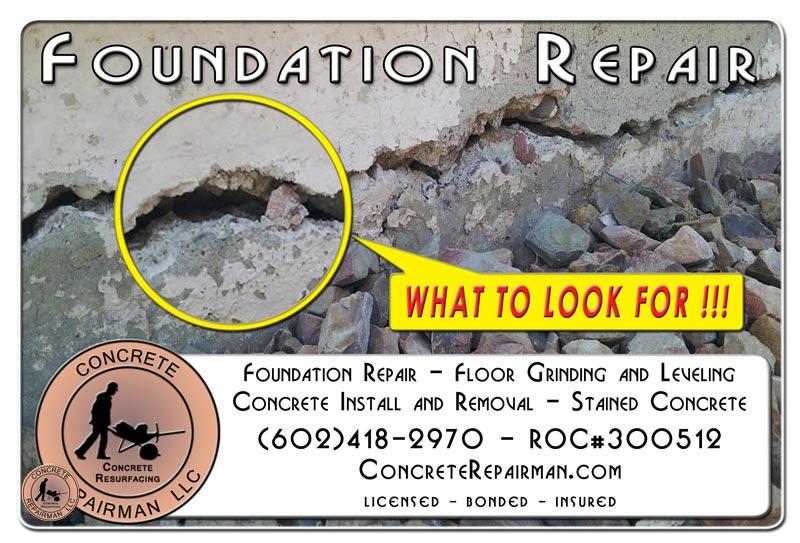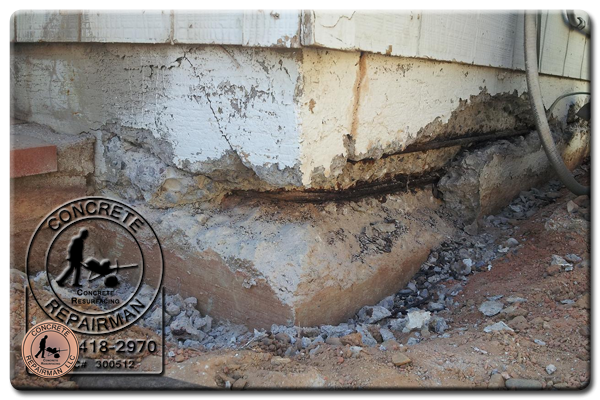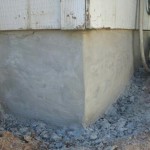Foundation Repair Concrete Repairman® We Fix It Right™
Licensed, Bonded and Insured Commercial & Residential Foundation Repair Contractors - ROC# 300512 CR-9
Foundation Repair Concrete Repairman® We Fix It Right™
Licensed, Bonded and Insured Commercial & Residential Foundation Repair Contractors - ROC# 300512 CR-9

Maintaining your home’s foundation is important and it is recommended that you do what you can to make sure that it is problem free. Inspect your home’s foundation from time to time and be on the look out for any signs of damage or anything that does not look normal.
Some of the things to look for are chipping or peeling paint. Bubbles underneath the paint. Exposed areas of concrete. Any signs of cracking or crumbled concrete. In short anything that looks out of the ordinary.
Like any other repair you have done to your home the sooner you take care the problem the less the expense will be. The longer you let the problem go the more it will take in both time and money.
If you see anything that concerns you we can always come out a take a look at it and answer any questions you may have.
Foundation settlement an d movement requiring foundation repair can be caused by building on expansive clay, compressible or improperly compacted fill soils, improper maintenance around foundation, or water saturation. Whatever the cause, settlement can destroy the value of structures and even render them unsafe. If you see signs of foundation distress, don’t delay in getting your home repair problem solved. Experience has shown that there are certain portions of exposed concrete structures more vulnerable than others to deterioration from weathering in freezing climates. These are exposed surfaces of the top 2 feet of walls, piers, posts, handrails, and parapets; all of curbs, sills, ledges, copings, cornices, and corners; and surfaces in contact with spray or water at frequently changing levels during freezing weather. The durability of these surfaces can be considerably improved and serviceability greatly prolonged by preventive maintenance such as weatherproofing treatment with concrete sealing compounds. Selecting the most satisfactory protective treatment depends to a considerable extent upon correctly assessing the exposure environment.
d movement requiring foundation repair can be caused by building on expansive clay, compressible or improperly compacted fill soils, improper maintenance around foundation, or water saturation. Whatever the cause, settlement can destroy the value of structures and even render them unsafe. If you see signs of foundation distress, don’t delay in getting your home repair problem solved. Experience has shown that there are certain portions of exposed concrete structures more vulnerable than others to deterioration from weathering in freezing climates. These are exposed surfaces of the top 2 feet of walls, piers, posts, handrails, and parapets; all of curbs, sills, ledges, copings, cornices, and corners; and surfaces in contact with spray or water at frequently changing levels during freezing weather. The durability of these surfaces can be considerably improved and serviceability greatly prolonged by preventive maintenance such as weatherproofing treatment with concrete sealing compounds. Selecting the most satisfactory protective treatment depends to a considerable extent upon correctly assessing the exposure environment.  Concrete sealing compounds and coatings that provide good protection from weathering in an essentially dry environment may perform poorly in the presence of an abundance of water such as on some bridge curbs and railings, stilling basin walls, and piers. Freezing and thawing tests of concrete specimens protected by a variety of concrete sealing compounds and coatings, including linseed oil, fluosilicates, epoxy and latex paints, chlorinated rubber, and water-proofing and penetrating sealers, have been performed in Reclamation laboratories. These tests indicate that proprietary epoxy formulations, silicone and saline formulations, and the high molecular weight methylated formulations clearly excel in resisting deterioration caused by repeated freezing and thawing in the presence of water. None of these formulations, however, will totally “waterproof” concrete. That is, they will not prevent treated concrete from absorbing water and becoming saturated under conditions of complete and long-term submergence. Except for hand-placed mortar restorations and repair of deteriorated concrete, concrete sealing compounds are ordinarily not applied on new concrete construction. The treatments are most commonly used on older surfaces when the earliest visible evidence of weathering appears. That is, the treatment is best used before deterioration advances to a stage where it cannot be arrested. Such early evidence consists primarily of fine surface cracking, close and parallel to edges and corners. The need for protection also may be indicated by pattern cracking, surface scaling or spalling, and shrinkage cracking. By treatment of these vulnerable surfaces in the early stages of deterioration, later repairs may be avoided or at least postponed for a long time.
Concrete sealing compounds and coatings that provide good protection from weathering in an essentially dry environment may perform poorly in the presence of an abundance of water such as on some bridge curbs and railings, stilling basin walls, and piers. Freezing and thawing tests of concrete specimens protected by a variety of concrete sealing compounds and coatings, including linseed oil, fluosilicates, epoxy and latex paints, chlorinated rubber, and water-proofing and penetrating sealers, have been performed in Reclamation laboratories. These tests indicate that proprietary epoxy formulations, silicone and saline formulations, and the high molecular weight methylated formulations clearly excel in resisting deterioration caused by repeated freezing and thawing in the presence of water. None of these formulations, however, will totally “waterproof” concrete. That is, they will not prevent treated concrete from absorbing water and becoming saturated under conditions of complete and long-term submergence. Except for hand-placed mortar restorations and repair of deteriorated concrete, concrete sealing compounds are ordinarily not applied on new concrete construction. The treatments are most commonly used on older surfaces when the earliest visible evidence of weathering appears. That is, the treatment is best used before deterioration advances to a stage where it cannot be arrested. Such early evidence consists primarily of fine surface cracking, close and parallel to edges and corners. The need for protection also may be indicated by pattern cracking, surface scaling or spalling, and shrinkage cracking. By treatment of these vulnerable surfaces in the early stages of deterioration, later repairs may be avoided or at least postponed for a long time.